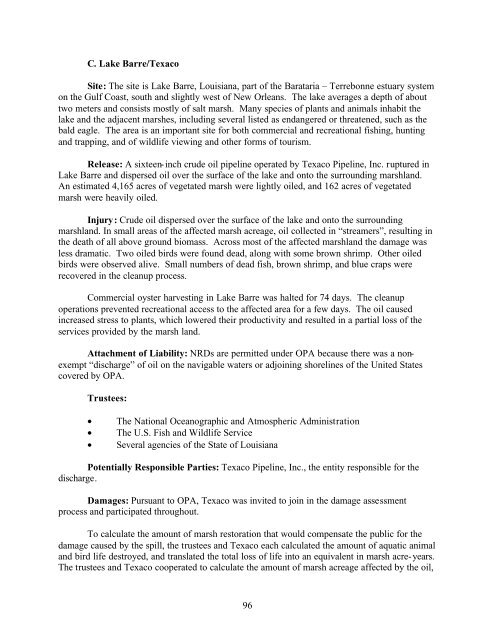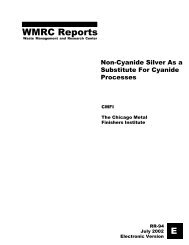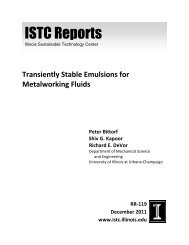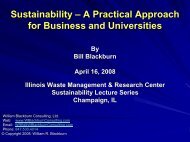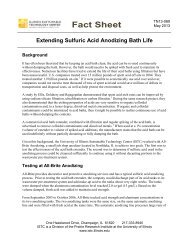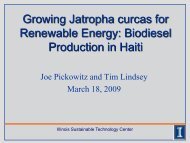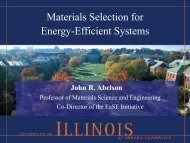Natural Resource Damage Assessment: Methods and Cases
Natural Resource Damage Assessment: Methods and Cases
Natural Resource Damage Assessment: Methods and Cases
You also want an ePaper? Increase the reach of your titles
YUMPU automatically turns print PDFs into web optimized ePapers that Google loves.
C. Lake Barre/Texaco<br />
Site: The site is Lake Barre, Louisiana, part of the Barataria – Terrebonne estuary system<br />
on the Gulf Coast, south <strong>and</strong> slightly west of New Orleans. The lake averages a depth of about<br />
two meters <strong>and</strong> consists mostly of salt marsh. Many species of plants <strong>and</strong> animals inhabit the<br />
lake <strong>and</strong> the adjacent marshes, including several listed as endangered or threatened, such as the<br />
bald eagle. The area is an important site for both commercial <strong>and</strong> recreational fishing, hunting<br />
<strong>and</strong> trapping, <strong>and</strong> of wildlife viewing <strong>and</strong> other forms of tourism.<br />
Release: A sixteen-inch crude oil pipeline operated by Texaco Pipeline, Inc. ruptured in<br />
Lake Barre <strong>and</strong> dispersed oil over the surface of the lake <strong>and</strong> onto the surrounding marshl<strong>and</strong>.<br />
An estimated 4,165 acres of vegetated marsh were lightly oiled, <strong>and</strong> 162 acres of vegetated<br />
marsh were heavily oiled.<br />
Injury: Crude oil dispersed over the surface of the lake <strong>and</strong> onto the surrounding<br />
marshl<strong>and</strong>. In small areas of the affected marsh acreage, oil collected in “streamers”, resulting in<br />
the death of all above ground biomass. Across most of the affected marshl<strong>and</strong> the damage was<br />
less dramatic. Two oiled birds were found dead, along with some brown shrimp. Other oiled<br />
birds were observed alive. Small numbers of dead fish, brown shrimp, <strong>and</strong> blue craps were<br />
recovered in the cleanup process.<br />
Commercial oyster harvesting in Lake Barre was halted for 74 days. The cleanup<br />
operations prevented recreational access to the affected area for a few days. The oil caused<br />
increased stress to plants, which lowered their productivity <strong>and</strong> resulted in a partial loss of the<br />
services provided by the marsh l<strong>and</strong>.<br />
Attachment of Liability: NRDs are permitted under OPA because there was a nonexempt<br />
“discharge” of oil on the navigable waters or adjoining shorelines of the United States<br />
covered by OPA.<br />
Trustees:<br />
• The National Oceanographic <strong>and</strong> Atmospheric Administration<br />
• The U.S. Fish <strong>and</strong> Wildlife Service<br />
• Several agencies of the State of Louisiana<br />
Potentially Responsible Parties: Texaco Pipeline, Inc., the entity responsible for the<br />
discharge.<br />
<strong>Damage</strong>s: Pursuant to OPA, Texaco was invited to join in the damage assessment<br />
process <strong>and</strong> participated throughout.<br />
To calculate the amount of marsh restoration that would compensate the public for the<br />
damage caused by the spill, the trustees <strong>and</strong> Texaco each calculated the amount of aquatic animal<br />
<strong>and</strong> bird life destroyed, <strong>and</strong> translated the total loss of life into an equivalent in marsh acre-years.<br />
The trustees <strong>and</strong> Texaco cooperated to calculate the amount of marsh acreage affected by the oil,<br />
96


